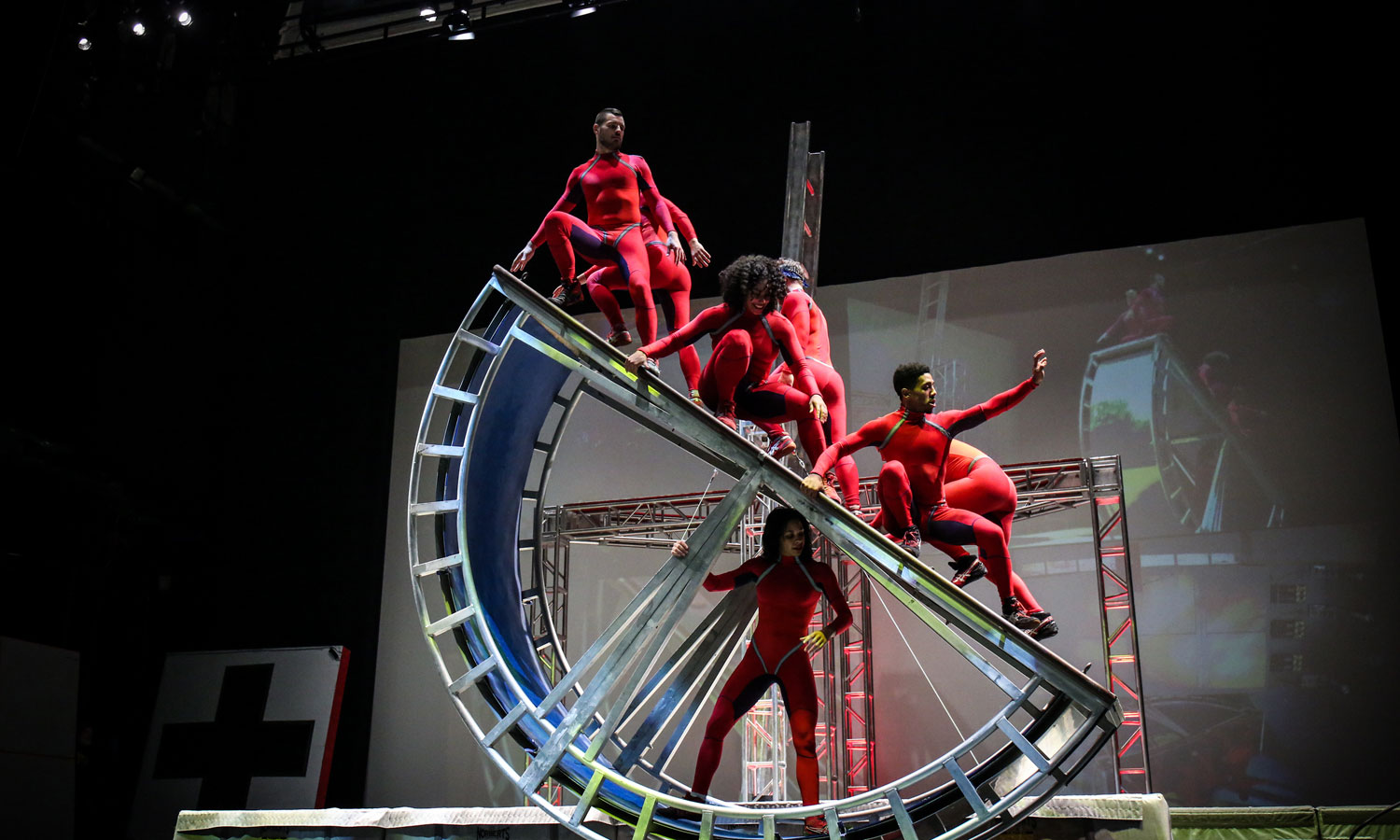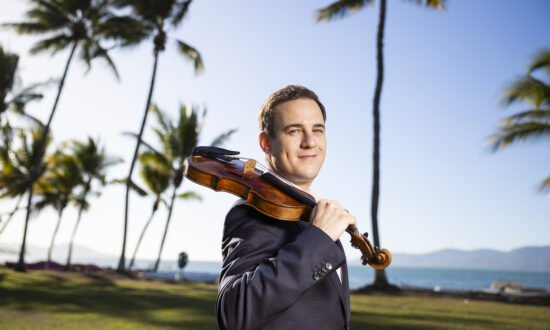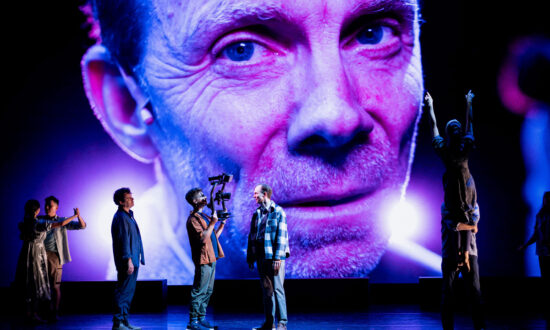There is something captivatingly fearless about legendary artist Elizabeth Streb and the edge-of-your-seat aerial works she creates.
The 73-year-old New Yorker has pioneered a new art form over the past 40 years which challenges our notions of movement, dance, gravity and “getting off the bottoms of our feet”.
With her team of young performers who form STREB EXTREME ACTION, Streb creates shows of death-defying acrobatics, mind-blowing action and don’t-try-this-at-home danger that have audiences gasping with fear and glued to the spectacle.

Elizabeth Streb in her New York warehouse. Photo: Ioulex
In 2012, as part of the cultural events around the London Olympics, Streb famously staged One Extraordinary Day, where her daredevil dancers performed extraordinary acts of danger and awe at some of London’s most famous tourist sites.
The grand-scale stunts included bungee jumping off the Millennium Bridge, abseiling down the City Hall building, flying from one of Streb’s “action machines” in a performance called “Human Fountain” at Trafalgar Square and attaching themselves to the spokes of the London Eye, performing 120 metres in the air in an after-dark extravaganza.
This month, the iconic performer and her troupe of nine dancers are in Adelaide to stage their latest work, Time Machine.
The show, being performed as part of the Adelaide Festival, incorporates giant metal “action machines”, prototypes invented by Streb which propel, hurl and spin her gymnastic performers into the air before they slam into padded mats.
“It really is this idea of higher, faster, sooner, harder,” Streb says. “I mean, this is rough trade, that’s my reputation in the dance world, but I am not a dancer. I’m an inventor of both machines – these Newtonian machines which promulgate force and hurl you, but there’s no motor.
“It’s all just like flying into the sky and figuring out how to do as many moves as you can until you smack down.
“I don’t really need to explain to the audience, ‘Here’s what we’re doing. I hope you understand’, because as a human being you understand the craziness of this. You can feel it.
“I think maybe the rhythm of action has not yet been named. It’s not music, it’s not language. It’s just being alive and acting like nothing’s ever going to happen to me.”
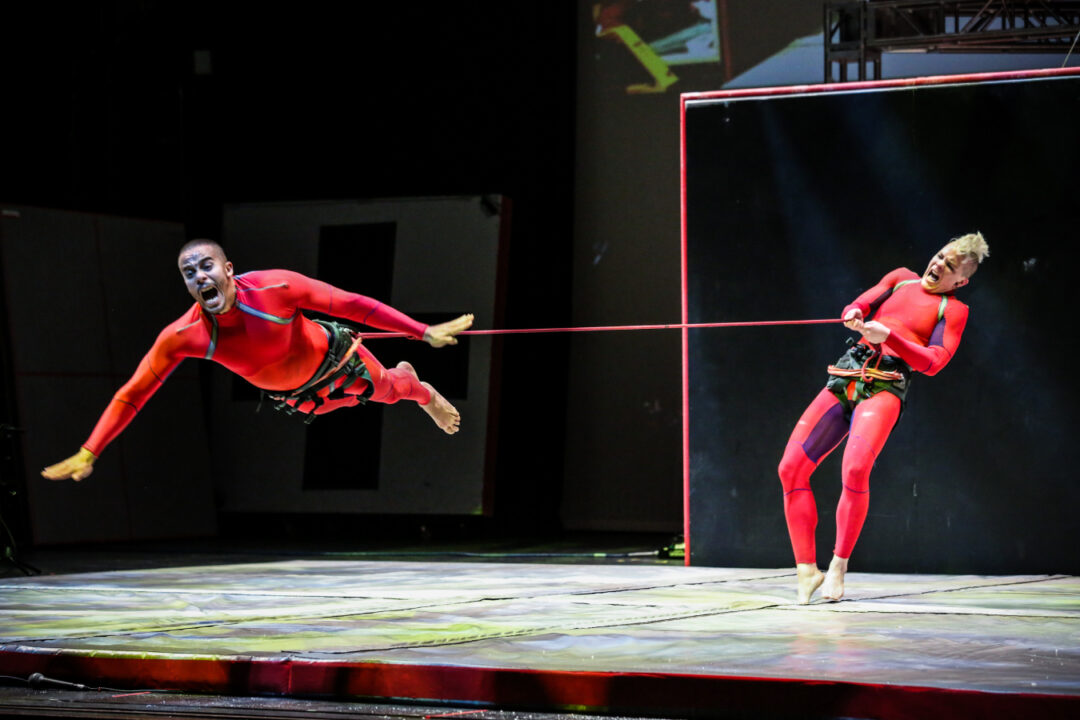
STREB EXTREME ACTION’s Time Machine. Photo: Ralph Alswang.
Streb has collaborated with Adelaide Festival artistic director Ruth Mackenzie over the years, including when Mackenzie was director of the Cultural Olympiad in London. This collaboration resulted in Mackenzie and WOMADelaide director Ian Scobie programming STREB EXTREME ACTION as part of this year’s festival activities.
It’s a major logistical undertaking to get Streb, her machines and the team here, with the metal action machines taking three months to reach Australia by boat.
“It was too expensive to fly it so it went by boat and then we don’t get it back until the end of June, so it’s a big forfeiture of our equipment,” Streb says. “But I love Australia and we are very honoured to be invited there to appear in two festivals.
“Ian Scobie and I have been talking for a few years and it was like, ‘Hey, come on, are you ever going to bring me out?’ And now Ruth and he figured out how to get us there so it’s very exciting.”
The Streb Australian entourage also includes a technical director, co-technical director and a sound engineer who Streb says “magically places” microphones in the mats on the floor and on the metal equipment to capture the yelling and impact of the dancers as they “have their way with gravity”.
“What we are looking for is the rhythm of the action,” she says.
“So, what you hear, part of the sound score is really the sound that extreme action makes. There is music as well but it doesn’t drown out the yelling of the dancers and the mic that captures the impact they make, which I hope and pray is a rhythmic idea.”
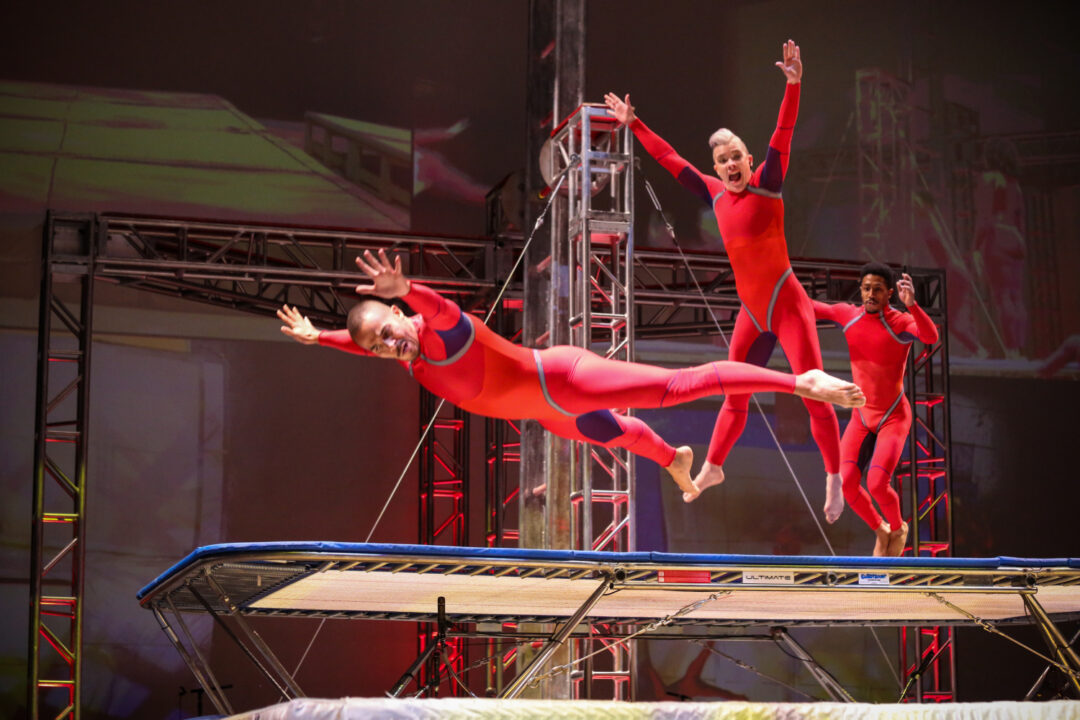
Streb calls her performers “action heroes”. Photo: Ralph Alswang
Streb’s troupe, or her “action heroes”, come from a variety of artistic backgrounds and include ballerinas, dancers and gymnasts. Co-artistic director Cassandre Joseph was a gymnast, while one of the senior action heroes, Jackie Carlson, trained as a ballerina.
Streb herself has always been physically active – she has a background as a skilled downhill skier, motorcycle rider and talented basketball player. She studied dance at the State University of New York in the 1970s, going on to push the boundaries of experimental dance and movement.
Although she stopped performing in 2010, she says she still lets “extreme things happen to me”, citing a recent fall in the street in New York.
“I looked up and there were hundreds of pigeons flying in a perfect circle. I was walking really fast because I was late for breakfast with my partner [high-profile US journalist Laura Flanders]. Then… I was on the ground, but my hands were out the front of me. I have no memory. I didn’t have time to think about putting my hands out, it just happened.
“So I think that pop action comes in very handy in your everyday life.”
While it was an accident, Streb took note, writing down some thoughts after the fall.
“You can’t make up a new move; new moves happen to you, and if you’re paying attention, you can jot it down on some level. It has to happen to your body. So my partner says, ‘You’ve got to stop falling’, and I say, ‘I’m not trying to fall down the stairs but I realise I can pay attention’. I’m 73 and I can still get back.”
we kind of expunge the fear element as best we can
What Streb and her performers have in common is a willingness to push their bodies to their physical limits, becoming beautiful airborne artists, unafraid to tackle the notion of gravity with a hardcore thud.
“If you’re not landing and using all the forces once your feet are off the ground that are available to you, if you’re not harnessing them with your skill set, then you’re just pretending,” Streb says. “You’re tiptoeing through the garden of fear and we kind of expunge the fear element as best we can.”
Streb says the impact of all this extreme movement can leave some of her performers feeling nauseous, so they have buckets at the side of the stage just in case.
“I hope this doesn’t happen but also the impact can build up. We also do back hits where they run into the plywood boards and do a 180 and grab the top of the board and fall back. You just have to have the right technique.
“But if it wasn’t dangerous, you’re being careful, and if you care more about yourself, rather than acquiring the skill to turn on a dime and land not on your feet, from high up on your stomach, if you can stay perfectly parallel to the earth, you can land on your stomach or back and not get hurt.
“That’s the other mild advantage of inventing movement that is filled with danger. If I was going to get really academic about it, I’d say modern dance started in the 1920s so it’s just 100 years old. I was nice for most of my career, but now I have really good criticisms of modern dance and that’s like, why are you right-side up all the time?
“You know, why aren’t you hurling yourself up and taking the hit when you land when gravity has its way with you?”
Streb founded STREB EXTREME ACTION in 1985 and in 2003, established SLAM, (STREB Lab for Action Mechanics). It is based in a large warehouse in New York with an open-door policy – passers-by can wander in and watch rehearsals, or book in for classes.
“This place is a public place. You watch rehearsals but people want to participate so there’s a flying trapeze and there’s STREB EXTREME ACTION and Kids’ Action [classes].
“It’s 5000 square feet and it’s 30 feet high, 100 feet long and 50 feet wide… the academy is always open to the public, so that’s the other beautiful thing about it.
“I love that it’s often people who would never walk into a dance show or any theatre, but they see this and they stop and they ask, ‘What’s going on around here?’, and I think that the element of surprise is almost a holy thing.
“If you can actually surprise someone who might look at it and say, ‘Oh, I never want to do that’ or ‘I’d love to do that’, then I think we’ve got their attention and that’s really a very blessed thing.

Get InReview in your inbox – free each Saturday. Local arts and culture – covered.
Thanks for signing up to the InReview newsletter.
“Seeing is believing.”
Elizabeth Streb and STREB EXTREME ACTION are presenting Time Machine at Her Majesty’s Theatre from March 14-17 as part of the Adelaide Festival. They will also be presenting performances near Stage 3 on every day of WOMADelaide, which is in Botanic Park from March 8-11.
Read more 2024 Adelaide Festival coverage here.
Support local arts journalism
Your support will help us continue the important work of InReview in publishing free professional journalism that celebrates, interrogates and amplifies arts and culture in South Australia.
Donate Here
